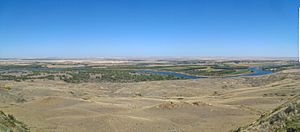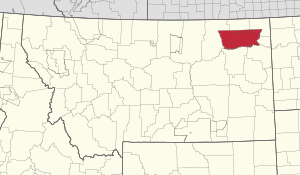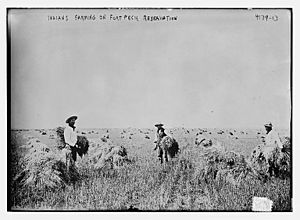Fort Peck Indian Reservation facts for kids
Quick facts for kids
Fort Peck Indian Reservation
|
|
|---|---|

Missouri River below Fort Peck Dam
|
|

Location in Montana
|
|
| Tribe | [Fort Peck Assiniboine and Sioux] |
| Country | United States |
| State | Montana |
| Counties | Daniels Roosevelt Sheridan Valley |
| Established | 1878 |
| Headquarters | Poplar |
| Government | |
| • Body | Fort Peck Tribal Executive Board |
| Area | |
| • Total | 2,093,318 acre (847,136 ha) |
| Dimensions | |
| • Length | 110 mi (180 km) |
| • Width | 40 mi (60 km) |
| Population
(2017)
|
|
| • Total | 10,374 |
| • Density | 3.24/sq mi (1.252/km2) |
| Time zone | UTC-7 (MST) |
| • Summer (DST) | UTC-6 (MDT) |
| Area code(s) | 406 |
| GDP | $385.9 Million (2018) |
| Website | fortpecktribes.org |
The Fort Peck Indian Reservation is a special area of land near Fort Peck, Montana. It is in the northeast part of the state. This reservation is home to several groups of Native American people. These groups include the Assiniboine, Lakota, and Dakota people tribes.
The reservation covers a huge area of about 2,094,000 acres (8,474 square kilometers). This makes it the ninth-largest Indian reservation in the United States. Its lands are spread across parts of four counties in Montana. These counties are Roosevelt, Valley, Daniels, and Sheridan. In 2000, about 10,381 people lived here. The biggest town on the reservation is Wolf Point.
Contents
History of Fort Peck Reservation
Early Years: 1850s to 1870s
The United States government created the Great Sioux Reservation in 1851. This large area covered much of what is now South Dakota. Some Sioux groups agreed to live on agencies, which were special areas set up by the government. Other groups, like those led by Sitting Bull, chose to resist.
In 1876, there was a big battle called the Battle of the Little Bighorn. The U.S. Army was defeated there. After this, Sitting Bull and his followers moved north. They sometimes got supplies from the Fort Peck Agency. When the army put more pressure on them in 1877, Sitting Bull went to Canada.
In 1878, the Fort Peck Indian Agency moved to its current spot in Poplar, Montana. The old location used to flood every spring. A new camp, Camp Poplar, was set up in 1880. Sitting Bull later returned to the U.S. and surrendered in 1881. Some of his followers stayed at Fort Peck and joined the Chelsea community.
Challenges and Changes: 1880s and 1890s
By 1881, the wild American bison (buffalo) were almost gone. Hunters had killed most of them. This caused big problems for the Native American tribes. Between 1883 and 1884, over 300 Assiniboine people died from hunger. They were living in very tough conditions at the Wolf Point sub-agency. Food was scarce, and the winters were very harsh.
In 1884, the Indian Rights Association helped get special money from Congress for Wolf Point. People also built a dam to help with irrigation for farming. From 1885 to 1889, the tribes made agreements with the U.S. government. They changed the reservation borders in exchange for government help.
In 1887, the Dawes Act was passed. This law allowed the government to divide tribal lands into smaller pieces for individuals. Around the early 1900s, more non-Native people started moving into the areas around the reservation. They wanted land for farming and grazing. This led to pressure on Congress to open up parts of the Fort Peck Reservation for new settlers.
Land Changes in the Early 1900s
On May 30, 1908, Congress passed the Fort Peck Allotment Act. This law said that the reservation lands would be surveyed and divided. Each Native American person could get 320 acres (1.3 square kilometers) of grazing land. They also got some timber and farming land. Some land was saved for schools, churches, and the Great Northern Railway. Any land left over was called "surplus" and could be sold to settlers.
In 1913, about 1,348,408 acres (5,456.8 square kilometers) of tribal land were available for settlers. More land was divided up before the 1930s.
Modern Times
In 2015, the U.S. government offered to buy back land from nearly 12,000 individual owners at Fort Peck. This was part of a program to help Native American landowners. The program was set up after a big lawsuit about how the government managed money for Native American lands.
Education on the Reservation
Education has a long history at Fort Peck. A government boarding school started in 1877 but closed in the 1920s. Missionary schools also operated for a while but had limited success.
Today, five public school districts serve the Fort Peck Reservation. They provide education from elementary to high school. There is also a college on the reservation called Fort Peck Community College. It offers many different associate degrees. People have been working to improve the quality of education for children on the reservation.
About the Fort Peck Tribes
The Fort Peck Reservation is home to the Assiniboine and Sioux Tribes. These two nations are separate but speak related Siouan languages. The Sioux here include the Sisseton/Wahpetons, Yanktonais, and Teton Hunkpapa groups. The Assiniboine include the Canoe Paddler and Red Bottom bands.
There are about 11,000 enrolled members of the Fort Peck Tribes. About half of them live on the reservation. To be an official tribal member, a person must have at least 1/4 Fort Peck Indian blood. This is measured by the tribe.
The reservation is in the far northeast corner of Montana. It is on the north side of the Missouri River. The reservation is about 110 miles (177 kilometers) long and 40 miles (64 kilometers) wide. It covers about 2,093,310 acres (8,471.3 square kilometers). Of this, about 378,000 acres (1,530 square kilometers) are owned by the tribe. Another 548,000 acres (2,218 square kilometers) are owned by individual Native Americans. In total, Native Americans own about 926,000 acres (3,747 square kilometers).
About 6,000 of the 10,000 enrolled tribal members live on or near the reservation. Most people live near the southern border of the reservation. This area is close to the Missouri River and major roads like U.S. Highway 2. The Burlington Northern Railroad also runs through this area.
The Fort Peck Tribes are the biggest employer on the reservation. They have over 350 employees. Hunting big game (like deer or elk) on the reservation is only for enrolled tribal members. But hunting upland birds is open to everyone.
Bison Return to Fort Peck
In March 2012, 63 American bison were brought to the Fort Peck Indian Reservation. These bison came from Yellowstone National Park. They were released into a 2,100-acre (8.5 square kilometer) game preserve. This preserve is about 25 miles (40 kilometers) north of Poplar. This herd is special because it is one of the few that has not been mixed with cattle.
Native Americans celebrated this event. It happened more than a century after bison were almost completely wiped out. The Assiniboine and Gros Ventre tribes at the Fort Belknap Indian Reservation also received some of these bison.
In November 2014, 136 more bison from Yellowstone National Park joined the Fort Peck herd. The preserve has also grown to 13,000 acres (53 square kilometers). The Fort Peck Fish and Game department wants to have 1,000 bison. Scientists believe this is the number needed to help bison play their natural role in the environment again. The tribe continues to receive Yellowstone bison for care and transfer to other tribes.
Communities on the Reservation
Notable People from Fort Peck
- Dolly Akers, a lawmaker
- Amber Midthunder, an actress
- Chaske Spencer, an actor
- Minnie Two Shoes (1950–2010), a journalist and activist
- Frank W. Warner
- Horse's Ghost


